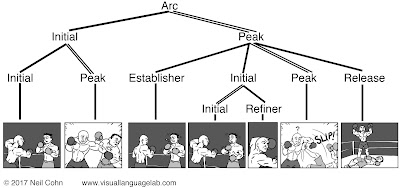New Paper: In defense of a “grammar” in the visual language of comics
I’m excited to announce that my new paper, “In defense of a ‘grammar’ in the visual language of comics” is now published in the Journal of Pragmatics. This paper provides an overview of my theory of narrative grammar, and rigorously compares it against other approaches to sequential image understanding.
Since my proposal that a “narrative grammar” operates to guide meaningful information in (visual) narratives, there have been several critiques and misunderstandings about how it works. Some approaches have also been proposed as a counterpoint. I feel all of this is healthy in the course of development of a theory and (hopefully) a broader discipline.
In this paper I address some of these concerns. I detail how my model of Visual Narrative Grammar operates and I review the empirical evidence supporting it. I then compare it in depth to the specifics and assumptions found in other models. Altogether I think it makes for a good review of the literature on sequential image understanding, and outlines what we should expect out of a scientific approach to visual narrative.
The paper is available on my Downloadable Papers page, or direct through this link (pdf).
Abstract:
Visual Language Theory (VLT) argues that the structure of drawn images is guided by similar cognitive principles as language, foremost a “narrative grammar” that guides the ways in which sequences of images convey meaning. Recent works have critiqued this linguistic orientation, such as Bateman and Wildfeuer’s (2014) arguments that a grammar for sequential images is unnecessary. They assert that the notion of a grammar governing sequential images is problematic, and that the same information can be captured in a “discourse” based approach that dynamically updates meaningful information across juxtaposed images. This paper reviews these assertions, addresses their critiques about a grammar of sequential images, and then details the shortcomings of their own claims. Such discussion is directly grounded in the empirical evidence about how people comprehend sequences of images. In doing so, it reviews the assumptions and basic principles of the narrative grammar of the visual language used in comics, and it aims to demonstrate the empirical standards by which theories of comics’ structure should adhere to.
Full reference:
Cohn, Neil. 2018. In defense of a “grammar” in the visual language of comics. Journal of Pragmatics. 127: 1-19

Comments